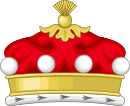Hugh Cholmondeley
1513–1596 |
|
| | | | | | | | | | | | |
| | | | | | | | | |
| | | | | Viscount Cholmondeley (1st creation), 1628
Earl of Leinster (1st creation), 1646
Baron Cholmondeley (1st creation), 1648 | | | | | |
|
Hugh Cholmondeley
d. 1655 | | Robert Cholmondeley
1584–1659
Earl of Leinster, Viscount Cholmondeley, and Baron Cholmondeley | | Thomas Cholmondeley
1601–1652 |
|
| | | | | Earldom of Leinster (1st creation, and subsidiary titles) extinct, 1659 | | | | | |
|
| Viscount Cholmondeley (2nd creation), 1661 | | | | | | | | | |
|
Robert Cholmondeley
d. 1681
1st Viscount Cholmondeley | | | | | | Thomas Cholmondeley
1627–1702 |
|
| | | | | | | | | | | | | |
| | | | |
Baron Cholmondeley, 1689
Earl of Cholmondeley and Viscount Malpas, 1706 | | Baron Newborough, 1715
Baron Newburgh, 1716 | | | | | | | Earl of Leinster (2nd creation), 1721
Unrelated to the Cholmondeley family, but holding the Leinster title |
|
Hugh Cholmondeley
1662–1725
1st Earl of Cholmondeley, Viscount Malpas, and Baron Cholmondeley
2nd Viscount Cholmondeley | | George Cholmondeley
1666–1733
2nd Earl of Cholmondeley, Viscount Malpas, and Baron Cholmondeley
3rd Viscount Cholmondeley, 1st Baron Newborough and Baron Newburgh | | Charles Cholmondeley
1685–1759 | | Sophia von Kielmansegg
1675–1725
Countess of Darlington and Countess of Leinster |
|
| | | | | | | | | | | | | | Earldom of Leinster (2nd creation) extinct, 1725 |
|
| | | | George Cholmondeley
1703–1770
3rd Earl of Cholmondeley, Viscount Malpas, and Baron Cholmondeley
4th Viscount Cholmondeley, 2nd Baron Newborough and Baron Newburgh | | | | | |
|
| | | | | | | | | | | | |
|
| | | | George Cholmondeley
1724–1764
styled Viscount Malpas | | Thomas Cholmondeley
1726–1779 |
|
| | | | | | | | | | | | |
|
| | | | Marquess of Cholmondeley and Earl of Rocksavage, 1815 | | Baron Delamere, 1821 |
|
| | | | George James Cholmondeley
1749–1827
1st Marquess of Cholmondeley and Earl of Rocksavage
4th Earl of Cholmondeley, Viscount Malpas, and Baron Cholmondeley
5th Viscount Cholmondeley, 3rd Baron Newborough and Baron Newburgh | | Thomas Cholmondeley
1767–1855
1st Baron Delamere |
|
| | | | | | | | | | | | | |
| | | | | |
George Horatio
1792–1870
2nd Marquess of Cholmondeley and Earl of Rocksavage
5th Earl of Cholmondeley, Viscount Malpas, and Baron Cholmondeley
6th Viscount Cholmondeley, 4th Baron Newborough and Baron Newburgh | | William Henry Hugh Cholmondeley
1800–1884
3rd Marquess of Cholmondeley and Earl of Rocksavage
6th Earl of Cholmondeley, Viscount Malpas, and Baron Cholmondeley
7th Viscount Cholmondeley, 5th Baron Newborough and Baron Newburgh | | Hugh Cholmondeley
1811–1887
2nd Baron Delamere |
|
| | | | | | | | | | | | |
|
| | | | Charles George Cholmondeley
1829–1869 | | | | | |
|
| | | | | | | | | | | | |
|
| | | | George Henry Hugh Cholmondeley
1858–1923
4th Marquess of Cholmondeley and Earl of Rocksavage
7th Earl of Cholmondeley, Viscount Malpas, and Baron Cholmondeley
8th Viscount Cholmondeley, 6th Baron Newborough and Baron Newburgh | | Hugh Cholmondeley
1870–1931
3rd Baron Delamere |
|
| | | | | | | | | | | | |
|
| | | | George Horatio Charles Cholmondeley
1883–1968
5th Marquess of Cholmondeley and Earl of Rocksavage
8th Earl of Cholmondeley, Viscount Malpas, and Baron Cholmondeley
9th Viscount Cholmondeley, 7th Baron Newborough and Baron Newburgh | | Thomas Pitt Hamilton Cholmondeley
1900–1979
4th Baron Delamere |
|
| | | | | | | | | | | | |
|
| | | | George Hugh Cholmondeley
1919–1990
6th Marquess of Cholmondeley and Earl of Rocksavage
9th Earl of Cholmondeley, Viscount Malpas, and Baron Cholmondeley
10th Viscount Cholmondeley, 8th Baron Newborough and Baron Newburgh | | Hugh George Cholmondeley
1934–2024
5th Baron Delamere |
|
| | | | | | | | | | | | |
|
| | | | David George Philip Cholmondeley,
b. 1960
7th Marquess of Cholmondeley and Earl of Rocksavage
10th Earl of Cholmondeley, Viscount Malpas, and Baron Cholmondeley
11th Viscount Cholmondeley, 9th Baron Newborough and Baron Newburgh | | Thomas Patrick Gilbert Cholmondeley
1968–2016 |
|
| | | | | | | | | | | | | | | | | |
| | | | |
| | | | Alexander Hugh George Cholmondeley
b. 2009
styled Earl of Rocksavage
Heir apparent to the Marquess of Cholmondeley | | Hugh Cholmondeley
b. 1998
6th Baron Delamere | | Henry Cholmondeley
b. 2000
Heir presumptive to the Baron Delamere |
|



